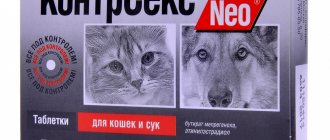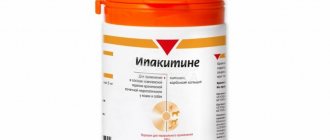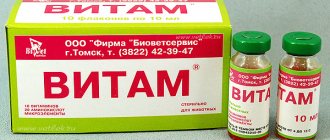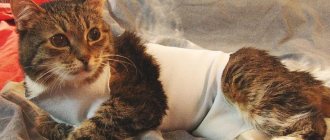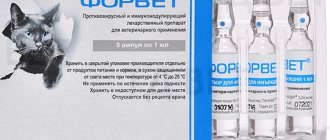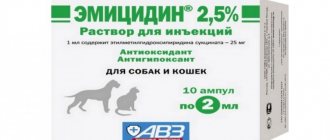General information
“Sporovit” for pets is a probiotic aimed at treating a variety of pathologies, chronic diseases, viruses, fungal diseases, etc. “Sporovit” is also used to protect the immunity of animals and prevent diseases.
© shutterstock
A distinctive feature of this product is its composition: “Sporovit” contains live bacteria called Bacillus subtilis (otherwise known as Bacillus subtilis bacteria). The substances they form in the body have properties similar to those of antibiotics.
The bacteria contained in “Sporovit”, after ingestion, are activated in the cat’s body, producing a variety of nutrients: fiber, proteins, enzymes and other active components aimed at maintaining immunity and treating animals.
Composition and action
The complex veterinary drug contains as active substances:
- cypermethrin;
- amitraz.
The first substance has a contact and systemic insectoacaricidal effect. It consists of blocking the parasite’s nerve impulses, which leads to paralysis and subsequent death of the insect. Amitraz acts on certain receptors of the parasite, causing disruption of motor reflexes. The result of the drug is paralysis and death of the insect.
The combined drug Tsipam exhibits pronounced activity against ectoparasites:
- fleas;
- lice eaters;
- lice;
- ticks that parasitize pets - cats and dogs.
The drug is used externally, applied to the animal’s body, then its components are distributed over the pet’s skin, accumulating in the upper layers of the skin, sebaceous glands, and hair follicles. This ensures a prolonged effect of the drug, which reliably protects the animal from ecoparasites.
Important!
Moderately dangerous for cats and dogs, the drug is toxic to fish and aquatic animals, as well as to bees.
Indications for use
"Sporovit" has a fairly large number of indications for use, because aimed at treating a wide variety of diseases and viruses.
- Bacterial/viral infections If an animal is susceptible to any virus or disease associated with bacteria (this could be fungal viruses, etc.), Sporovit is often prescribed in combination with other drugs.
- Gastrointestinal diseases The gastrointestinal tract is a very sensitive part of the cat’s body. Since she is often exposed to a variety of ailments, she often needs medicinal treatment. “Sporovit” is also used to eliminate liver diseases, various forms of gastritis, etc.
- Respiratory problems
- Pathologies associated with the cat's respiratory tract (bronchitis, pneumonia) can also be eliminated with the help of Sporovit.
- Kidney diseases
- It is often recommended to give Sporovit to a cat if there are some kidney problems.
- Purulent-septic diseases
- Otitis, staphylococcal infection and other purulent-septic diseases are also successfully treated with the help of the described drug.
- Restoration of the body
- A cat's delicate body is often weakened after a course of antibiotics. “Sporovit” helps bring it back to normal and improves the microflora after taking antibiotics and after illness in general.
- Dysbacteriosis
- If a cat is susceptible to dysbacteriosis, “Sporovit”, due to the presence of beneficial bacteria in it, will help get rid of this disease.
- Weight gain
- After illness or due to the presence of congenital abnormalities, the cat may lack body weight. The drug "Sporovit" is prescribed for a cat to increase its muscle mass and also improve its appetite.
The best drops for ear mites
If you are faced with the problem of ear mites in your pet for the first time, it will be quite difficult to choose suitable ear drops for cats against mites. All medications are effective in their own way, but some can cope with the disease only at the initial stage, while others destroy not only the adult individual, but also its larvae. Therefore, before purchasing, read the instructions carefully
Bars based on diazinon
In the production of this veterinary drug, diazinon is used as an active ingredient.
The medicine has acaricidal, antiseptic, anti-inflammatory and decongestant properties. In both ears - healthy and infected - 3 drops are instilled twice with a 5-8 day interval. In cases aggravated by complications, another procedure may be required after 25–30 days. Leopard relieves itching, inflammation and stimulates the healing of wounds and scratches. The cost of a 20 ml bottle is about 150 rubles. Prohibited in case of hypersensitivity to the components of the drug, as well as in case of perforation of the eardrum.
Amitrazine Plus
The drug is sold in 10 ml packages, its cost is 75-85 rubles. Active ingredients: amitraz, decamethoxin.
Instructions and dosage
Treatment of a pet can be carried out independently (only as prescribed by a doctor) and in severe cases - within the walls of a veterinary clinic.
Dosage used: 1 ml per 10 kg of pet’s weight.
In case of exacerbation of urolithiasis, veterinarians recommend intramuscular (in the thigh of the hind leg) or subcutaneous (in the withers) injections 2 times a day with an interval of 12 hours.
Tablets or drops are given orally in the morning and evening. The course of therapy ranges from 7 to 14 days, depending on the effect obtained and the severity of symptoms.
For symptoms of cystitis and urethritis, the drug is administered subcutaneously 2-3 times a day for a week.
For nephritis and pyelonephritis, the course of treatment is from 14 to 28 days. The drug can be used subcutaneously, intramuscularly and orally.
To prevent diseases of the urinary system in neutered cats, the medicine is added to their food once a day. This therapy is carried out twice a year in courses of 2 weeks.
Description of the drug
Vetom 1.1 belongs to the category of probiotics. It is produced in the form of a fine-grained, odorless, white powder. It dissolves well in water, forming a translucent suspension similar to diluted milk. Pharmacies sell bags of 5 grams and plastic tubes weighing 50 grams. There are also packaging options of 0.1, 0.2, 0.3, 0.5, 1, 2 and 5 kg - such large packages are suitable for treating cattle or purchasing in veterinary clinics. The manufacturer of the drug is NPF Research Center LLC (Russia).
Instructions for use of the drug ASD fraction 2 for dogs
In the article I will talk about the drug ASD fraction 2, its release form, the composition of the drug, recommendations and instructions for use, and the mechanism of action. I will describe the methods of use and recommended dosage for cats and dogs. I will explain the storage conditions of the medicine and expiration dates.
Dorogov's antiseptic stimulant fraction 2 is an antiseptic drug with a pronounced immunomodulatory and growth-stimulating effect.
Historical information about origin
The goal of the Soviet scientist’s work was to create a universal protective medicine suitable for all organs and tissues. Increases the body's resistance to various infections. Began to be used in 1947.
Today, ASD 2 is widely used in veterinary medicine and is prescribed for the treatment of many diseases. The medicine is inexpensive and effective.
Release form and composition of the drug ASD fraction 2
Manufacturers:
- Armavir Biofactory;
- NVC Agoravetzaschita;
- Novogaleschinskaya biofactory.
The drug is available in the form of a light yellow liquid with a brownish or reddish tint. The taste and smell of the medicine are sharp and unpleasant, pronounced.
The drug is available in the form of a light yellow liquid.
Packaged in dark glass bottles from 10 ml to 100 ml.
Made from ground meat and bone meal.
Compound:
- compounds of active sufhydral group;
- aliphatic amine derivatives;
- carboxylic acids;
- hydrocarbons (aliphatic and cyclic).
Indications for use and mechanism of action
ASD fraction 2 has a positive effect on:
- circulation;
- metabolism (absorption of nutrients and microelements);
- respiratory function;
- cardiac activity;
- restoration of nervous system functions;
- functioning of the digestive organs;
- regenerating function of cells and tissues;
- improves the growth and development of young animals.
ASD 2F improves the growth and development of young animals
Recommended for use in dogs:
- diseases of the digestive system;
- diseases of the respiratory system;
- diseases of the genitourinary system;
- skin diseases;
- eye and ear infections;
- oncological diseases;
- to stimulate growth and development;
- to improve the functioning of the nervous system;
- for recovery after illness;
- to normalize blood pressure;
- during inflammatory processes in the body;
- with weakened immunity;
- when exhausted;
- in the postoperative period.
ASD 2, consisting of the smallest biologically active substances, penetrates all organs, tissues and cells of the body and has a beneficial effect on them.
Dosage for dogs and method of administration
Dosage is calculated individually
The weight and disease of the animal are taken into account. Before use, the drug is diluted with drinking water in the proportion of 1 ml of medication per 20 ml of water. There are 40 drops in 1 ml of solution.
The course of treatment consists of two approaches with a break. From 5 to 14 days the medicine is given, 2 days are skipped, then ASD 2 is repeated.
The drug is given once a day (except in cases of cancer) in the morning 15 minutes before meals.
It is possible to use oil-based compresses with the addition of ASD 2. Pharmaceutical oils (linseed, castor, fish oil) are used to prepare the solution. Before applying the compress, it is necessary to treat the wound with warm boiled water with ASD.
Dosage:
- for dogs - 0.1 ml ASD 2 per 1 kg of weight;
- for cats - 1 drop per 5 kg of body weight (for preventive purposes). The maximum dose for a cat per day is 2 drops per 5 kg (for therapeutic and prophylactic purposes).
During use, it is necessary to provide the pet with constant access to drinking water.
When exposed to air, the drug changes its properties, so the dose must be taken from the bottle with a syringe through a puncture in the rubber stopper. Solutions should be prepared immediately before use.
You need to draw the drug with a syringe
Contraindications for use
A contraindication for taking ASD 2 is the pet’s high blood clotting and individual intolerance.
Conditions and expiration dates
The product should be stored at room temperature, in a dark place.
The shelf life is 4 years. After opening the bottle - no more than two weeks.
Price and analogues
ASD 2 is available in all veterinary pharmacies. The cost is on average 150 rubles for 20 ml and 300 rubles for 100 ml.
In the article, I talked about the drug ASD 2. I described in what form it is produced, the composition of the drug, indications for use, mechanism of action. She explained how the dosage is used and calculated for cats and dogs. Listed storage conditions and expiration dates.
What can replace the medicine?
In veterinary medicine, medications are used that replace Canephron in case of individual intolerance.
The animal is prescribed Lespefril. The drug removes nitrogenous compounds from the blood in chronic renal failure. The medication is prescribed 1-2 ml 4 times a day. The course of therapy is 7 weeks.
Cyston is also a herbal preparation, has an antimicrobial effect, dissolves kidney stones with urolithiasis.
The medication is an additional means of enhancing immunity, because When sick, the animal becomes unprotected from any viral infection.
The drug Kantaren is produced in injection and tablet forms and is prescribed for the prevention and treatment of urinary tract pathologies in cats.
This homeopathic remedy removes stones and has the following effects:
- eliminates inflammation;
- has an antispasmodic effect;
- has diuretic properties;
- restores the epithelium of the urinary tract.
The drug is safe and does not irritate the kidney tissue. Injections of the drug are prescribed intramuscularly and subcutaneously.
Side effects and contraindications
Experience has shown that with long-term use of ASD-2, in rare cases, an increase in blood density is possible. Therefore, monitoring the progress of treatment is necessary. Especially for older cats.
Despite the fact that no contraindications or side effects were found when treating with the ASD-2 stimulant in accordance with the instructions, cats, like people, may experience individual intolerance to the drug.
During the course of treatment, you must ensure that the cat drinks water. The more liquid an animal consumes, the faster its body will cleanse itself of toxins.
Despite the fact that ASD-2 has a wide spectrum of action and has no contraindications, it should not be used for the prevention and treatment of diseases without consulting a veterinarian. Self-medication of a cat can be dangerous to the life and health of the animal.
If your pet is sick, ASD 2 for cats is often prescribed. The drug has a rich composition and improves metabolic and digestive processes, prevents the progression of inflammatory processes. The owner of the animal should know the mechanism of action of the drug, indications and contraindications, and also take into account possible side effects.
Instructions and dosage
The injection solution is considered the most potent form. It is necessary to calculate the dosage according to the weight of the animal to reduce the risk of side effects.
For weights up to 2 kg, the drug is used in a dose of 0.5 ml. For larger pets - 1 ml. Opened ampoules cannot be stored. At home, it is better to inject the medicine intramuscularly (into the thigh) or subcutaneously on the 1st and 2nd days of the disease, then every other day. The course of treatment is 8 days.
The ointment is applied to the affected parts of the body in a thin layer, carefully spreading the hair. Once on warm skin, it is quickly absorbed, so no bandage or patch is used. A veterinary collar is worn if the animal licks the liniment after application. Apply for 5 days, 2 times a day.
Thiamine vitamin B1 deficiency in cats and dogs Veterinary clinic of Dr. Shubin
Thiamine deficiency in cats and dogs – brain damage (metabolic encephalopathy) due to the low content of this vitamin in the animal’s body.
Vitamin B1 (thiamine) is a water-soluble vitamin that comes from food; dogs and cats are not able to synthesize it in the body on their own.
Thiamine is necessary for the normal metabolism (conversion) of glucose in the Krebs cycle in the animal’s body; with a deficiency of vitamin B1, the tissues that receive energy from this cycle are primarily affected.
With thiamine deficiency, the main disorders develop in the nervous tissues; several theories of the development of the lesion have been proposed, each of which has both its supporters and opponents.
Be that as it may, with vitamin B1 deficiency, the lesions are mainly localized in the brain stem, with bilateral symmetrical degeneration of its nuclei (caudal quadrigeminal nuclei, vestibular nuclei, lateral geniculate nucleus and red nucleus), and damage to the cerebral cortex with thiamine deficiency. observed quite rarely.
The main cause of thiamine deficiency is feeding animals raw fish; it contains the enzyme thiaminase, which destroys vitamin B1 and prevents its entry into the animal’s body.
Another cause of vitamin B1 deficiency in an animal’s diet is excessive temperature treatment of feed, which destroys thiamine reserves and prevents its entry into the body of cats and dogs.
Preservation of feed using sulfur dioxide and sulfites also leads to the destruction of vitamin reserves, but manufacturers have managed to circumvent this problem and thiamine deficiency practically does not occur when feeding industrial feeds.
Thiamine deficiency is a fairly rare, but still common pathology in cats and dogs. At a veterinary clinic, this disease is usually diagnosed in cats due to feeding raw fish.
Clinical signs
Signs of neurological disorders due to thiamine deficiency are associated with damage to the nuclei of the brain stem, they may include such manifestations as generalized loss of coordination of movements (vestibular ataxia), trembling (tremor) in the body and limbs, convulsions, dilated pupils, contraction of the muscles of the back and neck with throwing back head (opisthotonus), coma and death (untreated). Also, during an appointment at a veterinary clinic, weakness of the head and neck muscles with the animal’s head tilting down and general weakness of the animal with decreased appetite are often noted.
Diagnostics
A presumptive diagnosis of vitamin B1 deficiency is made on the basis of neurological impairment, the animal's feeding habits, and the response to a trial treatment with thiamine (usually subcutaneous or intramuscular administration of the drug).
In order to make a final diagnosis of vitamin B1 deficiency and exclude diseases with similar symptoms, magnetic resonance imaging (MRI) and determination of blood concentrations of pyruvate and lactate may be required. These types of studies are used quite rarely in a veterinary clinic; usually, characteristic clinical signs together with a positive response to parenteral administration of thiamine are sufficient.
The list of differential diagnoses for thiamine deficiency includes diseases such as inflammation of the brain and its membranes (meningoencephalitis), brain tumors, metabolic or toxic encephalopathies, as well as other diseases accompanied by impaired coordination of movements.
Treatment and prognosis
Treatment of thiamine deficiency is carried out through parenteral administration of vitamin B1 (subcutaneously or intramuscularly), the immediate dose of the drug is selected by a veterinary clinic doctor.
A positive response to treatment is usually observed within 3-7 days from the start of therapy, sometimes it takes a little more time (for severe lesions), after which the dose of the drug is slightly reduced.
Subsequently, the animal can be transferred to enteral (with food) administration of the drug; the total treatment time with thiamine is usually 3 weeks (21 days).
Photo 1. View of a 12-year-old animal with suspected vitamin B1 (thiamine) deficiency.
The owner contacted the veterinary clinic regarding weakness of the hind legs and general depression; the medical history revealed prolonged feeding of raw fish; at the time of examination, impaired coordination of movements and general tremor were detected. Following parenteral administration of vitamin B1, the cat showed normalization of nervous system function.
Veterinary clinic of Dr. Shubin, Balakovo

